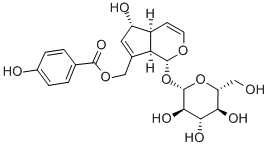11027-63-7

Product Name:
Agnuside
Formula:
C22H26O11
Synonyms:
(1S,4aR,5S,7aS)-1,4a,5,7a-Tetrahydro-5-hydroxy-7-[[(4-hydroxybenzoyl)oxy]methyl]cyclopenta[c]pyran-1-yl β-D -glucopyranoside;Buddlejoside A
Inquiry
SAFETY INFORMATION
| Signal word | Warning |
|---|---|
| Pictogram(s) |
 Exclamation Mark Irritant GHS07 |
| GHS Hazard Statements |
H302:Acute toxicity,oral |
COMPUTED DESCRIPTORS
| Molecular Weight | 466.4 g/mol |
|---|---|
| XLogP3 | -1.1 |
| Hydrogen Bond Donor Count | 6 |
| Hydrogen Bond Acceptor Count | 11 |
| Rotatable Bond Count | 7 |
| Exact Mass | 466.14751164 g/mol |
| Monoisotopic Mass | 466.14751164 g/mol |
| Topological Polar Surface Area | 175 Ų |
| Heavy Atom Count | 33 |
| Formal Charge | 0 |
| Complexity | 747 |
| Isotope Atom Count | 0 |
| Defined Atom Stereocenter Count | 9 |
| Undefined Atom Stereocenter Count | 0 |
| Defined Bond Stereocenter Count | 0 |
| Undefined Bond Stereocenter Count | 0 |
| Covalently-Bonded Unit Count | 1 |
| Compound Is Canonicalized | Yes |
PRODUCT INTRODUCTION
description
Agnuside is a benzoate ester resulting from the formal condensation of the carboxy group of 4-hydroxybenzoic acid with the primary hydroxy group of aucubin. It is an iridoid glycoside found in several Vitex plants including Vitex agnus-castus. It has a role as a plant metabolite, an anti-inflammatory agent, a pro-angiogenic agent and a cyclooxygenase 2 inhibitor. It is a terpene glycoside, an iridoid monoterpenoid, a benzoate ester, a member of phenols, a beta-D-glucoside, a cyclopentapyran and a monosaccharide derivative. It is functionally related to an aucubin.